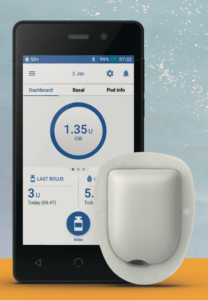When I spoke with Hannah McCook she was sitting in her car at the Gleneagles Golf Club in Scotland, hiding from the rain but about to go out and play golf. By Sue Marshall.
Hannah McCook is a professional golfer and an ambassador for Scotland’s famous Gleneagles Hotel and Golf Club. This means that she represents the club while she’s away playing. She feels she is ‘very fortunate’ because she can not only use the golf course but the practice range and gym. She’s been a Gleneagles ambassador since she turned professional at the end of 2018, so the 2019 season was her first and – so far – only normal golf season; the following year coronavirus hit and this year she’s had an injury she’s had to deal with.
“As an amateur player, I guess effectively it is purely for fun and preparing for whether or not you want to turn pro. The difference with being professional is you can earn money through tournaments and sponsorship,” says McCook, who first played golf at the age of six and then got her golf handicap* at the age of 11. She is now 28 and says, “I have always been into sport, all sports, as a kid, I particularly loved skiing but at the age of about 13 or 14 I stopped ski-racing and began to get better at golf. By the time I got to my mid-teens I played for Scotland for the first time and started to wonder if I could actually have a shot at making a career out of golf.”
McCook was diagnosed in February 2002 at the age of eight and says that she remembers it ‘like it was yesterday’. She recalls, “I’d been feeling ill for a few weeks I’ve been incredibly thirsty and always going to the loo. I was drinking any liquid I could find, even sweet things, which I know now would have been adding to the problem, but then I just remember thinking ‘it’s liquid, I need to drink it’.”
She had been sick pretty much on the hour all through Sunday night, so that by Monday her mother said she could stay off school and she’d take her to the doctors. “The doctor made me do a urine sample and a blood test and then they called an ambulance. I was taken directly to Raigmore Hospital in Inverness. All I understood was that there was an urgent need to get insulin inside me. I remember being told I was diabetic and I remember looking at my mum and thinking, ‘what does that mean?’ I was put on a drip and that was that.”
Game on
Four days later, McCook left the hospital with a handful of BD syringes (‘the ones with the orange lids’), some vials of insulin and a blood test machine. “I’m not sure what my first meter was, but I know I was soon on a One Touch meter. It turned out that the strips were being made in Inverness, later I even had a chance to go on a tour there. I still got a box of all my old kit at home even though some of it I can’t have used in 20 years.”
Another memorable part of that day was the ‘strangely good thing’, which was that one of the paramedics had a son of exactly the same age as McCook who had also been diagnosed with Type 1 diabetes the year before. “In fact, although we didn’t go to the same primary schools we ended up in the same secondary school,” says McCook, “His dad had said to me on the day, ‘diabetes will live with you, don’t you live with it.’ I remember that the four days in hospital, as I started to feel better, my parents and myself were learning about what living with diabetes was going to mean. I was particularly worried that I would not be allowed to do sport.
“My parents had gone home and done a bit of research. One of the first things they found out was that Steve Redgrave, the Olympian, had Type I diabetes. I was hugely relieved and just thought ‘right, let’s get on with this’. Two weeks later I was back to doing the same stuff as before, skiing, playing golf, just with a bit more preparation.”
Anyone who has Type 1 diabetes understands the need, like the boy scouts, to be prepared, the need to keep blood testing paraphernalia to hand and something to treat a hypo, as well as a means to deliver insulin into the body. Says McCook, “I thought about blood testing and eating in such a way that I was organised, from what I had for breakfast to when I had my injections. I always had extra food in my bag, my ski coach had emergency snacks – I just have them everywhere!
“I go through phases as to what I prefer to use if I go low, it depends where I am and what I’m doing at that moment. Currently I’m using little cartons of apple juice, or I take sips from a bottle of Lucozade. A few years ago, I remember being in my mother’s kitchen and she was about to start making the Christmas cake, she had some glacier cherries to go in the mix. I was a bit low and I just a handful of those and they worked perfectly. I still use them to this day. Just a few will do.”
Taking action
McCook is confident that she has good hypo awareness, even tending to pick up that something is going on before her CGM tells her she’s going too low. “I now use a Dexcom G6 sensor, which actually tracks the glucose in my interstitial glucose level, and I love the fact that you can see if you’re starting to trend down so you can take action before it happens. I remember my first meter taking about 20 seconds to count down to the result, then I got a new one that only took five seconds and that felt so quick.
“More recently, I was told about CGM by at clinic in Raigmore Hospital in the summer of 2016. I was really lucky to have a Dexcom trial that summer – I was away competing and Scottish Golf funded one month’s use for me while touring. However, when I was back home again it was quite annoying to go back to blood testing. I continued to ask for permanent use of the continuous glucose monitoring (CGM) and in 2017 the NHS agreed to fund me full time, which I am very thankful for.”
Use of CGM is not only for people who use insulin pumps, but then again, the two do often come together. Hannah McCook first went on a Medtronic insulin pump in October 2013, later moving onto the Lifescan’s Animas Vibe until that was discontinued in the UK. “At that point I had another look around,” says McCook, “But it was my pump nurse at Raigmore, who also had Type I diabetes, who suggested the Omnipod Dash insulin pump. Since August 2018 I’ve been using that and I find it totally suits my lifestyle.
These two bits of diabetes technology – Dexcom and Omnipod – do not currently ‘talk’ to each other — they are not a ‘closed loop’ system. They two systems operate separately but side-by-side. “Dexcom gives you information that you then use to assess what bolus to give yourself from the pump,” says McCook, “I don’t find it’s any problem using the two. I know that some people do loop by using a third-party app to create a sort of artificial pump system but that’s not really appealed to me.
“I find that every day is different, it’s really hard to track patterns when that is the case. I do look at my weekly review from the Dexcom App, but I try not to get too bogged down by it all. With my Omnipod Dash system, people think I’ve got two mobile phones. If I sit down for dinner somewhere, people might question why I have two phones on the table, but one is actually my personal diabetes manager (PDM) for the pump while I see the Dexcom readings on an app on my phone, so I need both on the table. As I’m about to eat, I need to think about insulin dosing.
“I find using a pump so much better than injecting, so I’m entirely happy to work with it. When playing a game, I look at my phone every three or four holes – just a quick glance is all I need, though I know it’s also possible to use a Dexcom receiver too. But since Covid, when we’re playing, we need to use an app on our phone to log our scores. That’s been useful, as I’m able to check my blood glucose every hole now, as I’ve got another reason to pick my phone up to use it for the scoring system.”
Rain stops play
Hannah McCook is definitely on her game – she’s making a living from playing golf and has her diabetes control well in hand, so the future’s bright. “Looking back,” she says, “I can see how using Dexcom CGM and Omnipod has lessened my anxiety about living with diabetes, because it made life easier – although some days are still complicated. It’s much easier to travel now, as I don’t have to take lancets with me or needles, or have to find a bit flesh to stick an injection into every few hours.”
So, has the kit improved McCook’s control? McCook says, “I was always on top of it to be honest, but certainly seeing what’s going on means you can react quicker and that way avoid lows, so probably overall it has. Both my boyfriend and my mother used the Dexcom follow app. I guess it gives my mum a lot of peace of mind when I am out competing she can see what my levels are. It’s not just live scoring she watches, but that too! When at home I tend to have my phone on silent in order not to have too many alarms interrupting me, especially at bedtime. But as they are tracking me, if they don’t have their sound turned off, then they can tend to get quite a lot of alerts, which must be annoying. Especially when all they want is the best for me.”
Then, even on a daily basis, McCook says, “I can state for certain that not having to get blood out of a wet finger when you’re out playing golf in the rain, is not something I miss. Cold, wet fingers were even worse, and there’s a lot of those in Scotland!”
*A golf handicap is a measure of an amateur player’s ability to play golf. It allows players of all abilities to compete against each other equally. Golf handicaps can only be issued by a golf club that is affiliated with a Golf Union. A player must play a minimum of three 18-hole rounds of golf and submit these to be calculated by the golf club.





